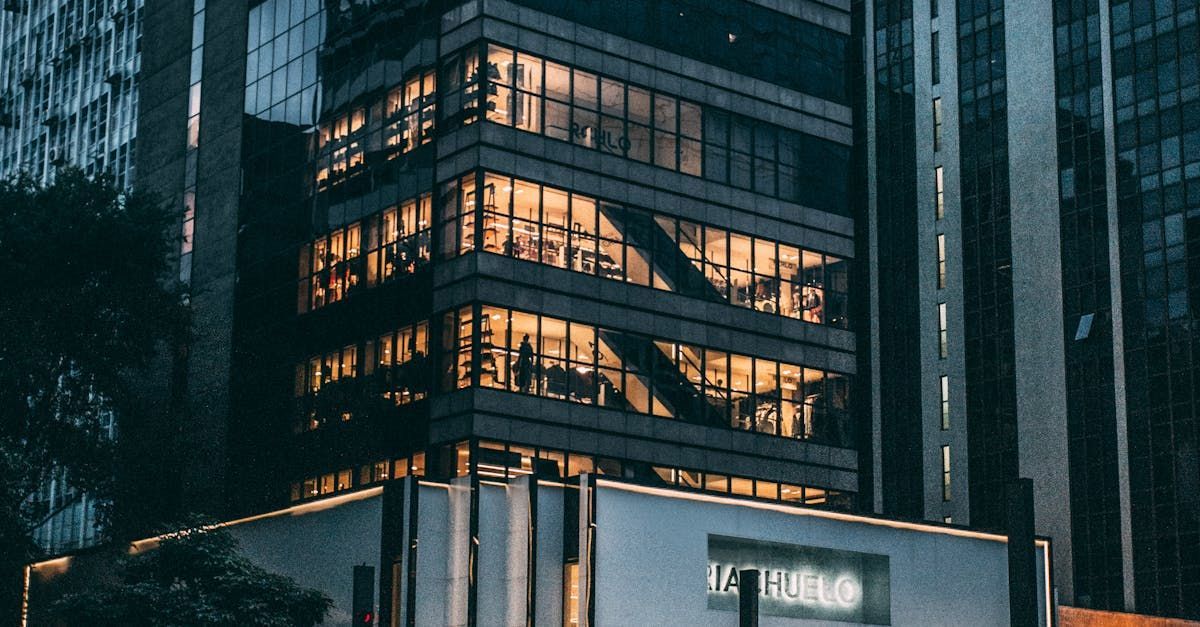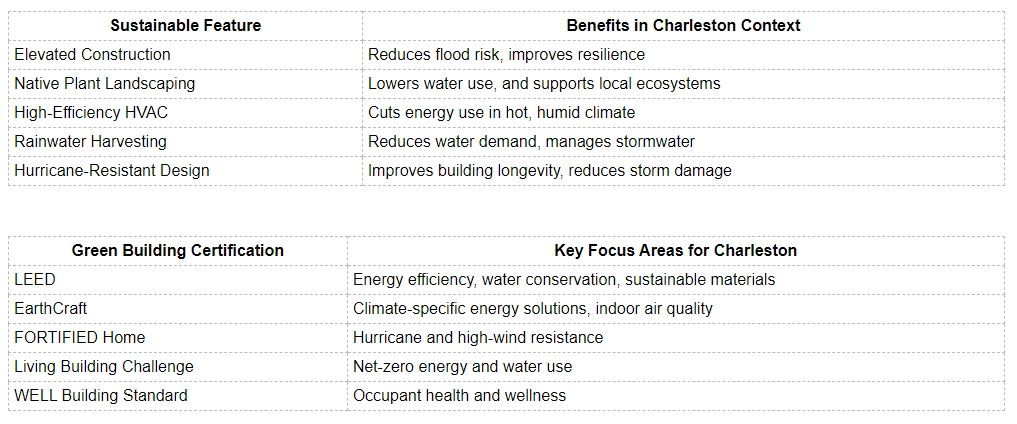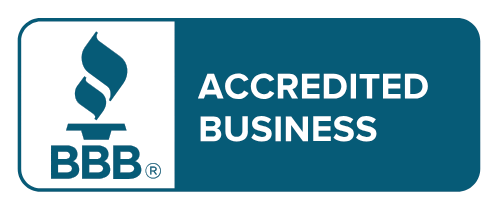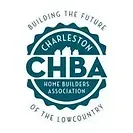Sustainable Building Practices: Charleston's Green Revolution
Key Takeaways
- Sustainable building practices in Charleston focus on energy efficiency, water conservation, and resilient design
- Local materials like reclaimed wood and oyster shells are used in eco-friendly construction
- Charleston's climate demands attention to hurricane resistance and flood mitigation in sustainable designs
- Green building certifications like LEED and EarthCraft are gaining popularity in the Lowcountry
- Preserving historic structures while improving sustainability is a unique challenge in Charleston
Sustainable building practices are becoming increasingly important in Charleston, South Carolina. As a coastal city with a rich architectural heritage, Charleston faces unique challenges and opportunities when it comes to green construction. Let's take a closer look at how sustainable building is taking shape in the Holy City.
The Charleston Context
Charleston's subtropical climate and coastal location create specific demands for sustainable building. With hot, humid summers and the threat of hurricanes, buildings need to be both energy-efficient and resilient. The city's historic charm also means that many sustainable projects involve renovating existing structures rather than new construction.
Climate Considerations
In Charleston, sustainable building practices must account for the local climate. This means designing for:
- High humidity levels
- Intense summer heat
- Potential flooding
- Hurricane resistance
Buildings that can withstand these conditions while minimizing energy use are key to sustainability in the Lowcountry.
Historic Preservation Meets Sustainability
Charleston's historic district presents a unique challenge for sustainable building. Many older homes and buildings need updates to improve energy efficiency, but these changes must be made without compromising historic integrity. This balancing act is a hallmark of sustainable construction in Charleston.
Energy Efficiency in the Lowcountry
Energy efficiency is a cornerstone of sustainable building, and in Charleston, it takes on special importance due to the hot climate.
Passive Solar Design
Passive solar design is gaining traction in Charleston. This approach uses the sun's energy for heating and cooling without mechanical systems. In Charleston, this often means:
- Orienting buildings to maximize natural light
- Using overhangs to shade windows during summer
- Incorporating thermal mass to regulate indoor temperatures
These techniques can significantly reduce energy needs in Charleston's climate.
High-Performance HVAC Systems
Given Charleston's hot summers, efficient cooling systems are crucial. Many sustainable buildings in the area are incorporating:
- Geothermal heat pumps
- High-efficiency air conditioners
- Smart thermostats
These systems can dramatically cut energy use while keeping buildings comfortable year-round.
Water Conservation Strategies
Water conservation is another key aspect of sustainable building in Charleston. With the threat of saltwater intrusion and periodic droughts, efficient water use is critical.
Rainwater Harvesting
Rainwater harvesting systems are becoming more common in Charleston. These systems collect rainwater from roofs and store it for non-potable uses like:
- Irrigation
- Toilet flushing
- Cooling tower make-up water
This practice reduces demand on the municipal water supply and helps manage stormwater runoff.
Low-Flow Fixtures
Installing low-flow fixtures is a simple but effective way to reduce water use in Charleston buildings. This includes:
- Dual-flush toilets
- Low-flow showerheads
- Sensor-activated faucets
These fixtures can cut water use by 30% or more compared to standard models.
Local and Sustainable Materials
Using local and sustainable materials is another important aspect of green building in Charleston.
Reclaimed Wood
Charleston's history provides a wealth of reclaimed wood for sustainable building projects. Old barns, warehouses, and even sunken ships can be sources of high-quality lumber. Using this reclaimed wood:
- Reduces demand for new timber
- Preserves the character of historic buildings
- Keeps materials out of landfills
Oyster Shell Construction
In a nod to Charleston's coastal heritage, some builders are incorporating oyster shells into sustainable construction. Oyster shells can be used in:
- Tabby concrete (a traditional Lowcountry building material)
- Landscaping and hardscaping
- Drainage systems
This practice recycles waste from the seafood industry and creates a uniquely local aesthetic.
Resilient Design for Coastal Living
Resilient design is crucial in Charleston due to its vulnerability to storms and sea-level rise.
Flood-Resistant Construction
Many new sustainable buildings in Charleston are designed to withstand flooding. This includes:
- Elevating living spaces above flood levels
- Using water-resistant materials on lower levels
- Installing backflow preventers on sewer lines
These measures help protect buildings and their occupants during extreme weather events.
Hurricane-Resistant Features
Hurricane resistance is another key consideration in Charleston's sustainable building practices. This often involves:
- Impact-resistant windows and doors
- Reinforced roof structures
- Secure connections between building components
These features not only protect buildings during storms but can also improve energy efficiency by reducing air leakage.

Green Building Certifications in Charleston
Several green building certification programs are gaining popularity in Charleston.
LEED Certification
Leadership in Energy and Environmental Design (LEED) certification is becoming more common in Charleston. LEED-certified buildings must meet strict standards for:
- Energy efficiency
- Water conservation
- Indoor air quality
- Sustainable materials use
Several new buildings in downtown Charleston have achieved LEED certification in recent years.
EarthCraft Certification
EarthCraft, a green building program developed in the Southeast, is well-suited to Charleston's climate and building traditions. EarthCraft certification focuses on:
- Energy and water efficiency
- Indoor air quality
- Sustainable site development
- Waste management
This program is particularly popular for single-family homes and multifamily buildings in the Charleston area.
Sustainable Renovations in Historic Charleston
Renovating historic buildings to improve sustainability is a common challenge in Charleston.
Energy Retrofits
Many historic homes in Charleston are undergoing energy retrofits. These often include:
- Adding insulation to walls and attics
- Upgrading to high-efficiency HVAC systems
- Installing energy-efficient windows that match historic styles
These upgrades can significantly reduce energy use while preserving the building's historic character.
Modern Systems in Historic Structures
Integrating modern, sustainable systems into historic buildings requires creativity. Some approaches used in Charleston include:
- Hiding solar panels behind parapet walls
- Installing geothermal systems under historic gardens
- Using mini-split HVAC systems to avoid ductwork in historic spaces
These solutions allow historic buildings to benefit from modern technology without compromising their appearance.
The Role of Local Government
Charleston's local government plays a significant role in promoting sustainable building practices.
Green Building Incentives
The City of Charleston offers several incentives for green building, including:
- Expedited permit reviews for LEED-certified projects
- Density bonuses for sustainable developments
- Reduced fees for energy-efficient renovations
These incentives help encourage developers and homeowners to prioritize sustainability.
Updated Building Codes
Charleston has updated its building codes to promote sustainability. Recent changes include:
- Higher energy efficiency standards
- Requirements for electric vehicle charging infrastructure
- Improved stormwater management regulations
These code updates help ensure that all new construction in Charleston meets a baseline level of sustainability.
Sustainable Landscaping in Charleston
Sustainable landscaping is an important complement to green building practices in Charleston.
Native Plant Gardens
Many sustainable projects in Charleston incorporate native plant gardens. These gardens:
- Require less water and maintenance
- Provide habitat for local wildlife
- Help manage stormwater runoff
Popular native plants include sweetgrass, yaupon holly, and Carolina jessamine.
Permeable Paving
Permeable paving is becoming more common in Charleston as a way to manage stormwater. This can include:
- Permeable concrete or asphalt
- Interlocking pavers with gravel-filled joints
- Grass pavers for low-traffic areas
These surfaces allow rainwater to infiltrate into the ground, reducing runoff and helping to recharge groundwater.
The Future of Sustainable Building in Charleston
As Charleston continues to grow and face environmental challenges, sustainable building practices will become increasingly important.
Adapting to Sea Level Rise
Future sustainable building in Charleston will need to address sea level rise. This may involve:
- Designing buildings that can be easily elevated
- Creating "sacrificial" first floors that can flood without major damage
- Incorporating natural flood barriers into site designs
These strategies will help ensure that new buildings can withstand changing environmental conditions.
Embracing Smart Building Technology
Smart building technology is likely to play a larger role in Charleston's sustainable future. This could include:
- Advanced energy management systems
- Real-time water use monitoring
- Automated shading systems
These technologies can help buildings operate more efficiently and respond to changing conditions.
Sustainable Building Education in Charleston
Education is key to advancing sustainable building practices in Charleston.
Local Training Programs
Several local institutions offer training in sustainable building techniques. For example:
- The Sustainability Institute offers workshops on energy-efficient retrofits
- Trident Technical College provides courses in green construction
- The Charleston chapter of the U.S. Green Building Council hosts regular educational events
These programs help build a workforce skilled in sustainable construction techniques.
Public Awareness Campaigns
Public awareness campaigns are helping to educate Charleston residents about the benefits of sustainable building. These efforts include:
- Tours of green buildings during the annual Charleston Green Fair
- Sustainable home showcases organized by local environmental groups
- Information booths at community events
These initiatives help build public support for sustainable building practices.
Challenges and Opportunities
While Charleston has made significant progress in sustainable building, challenges remain.
Balancing Preservation and Sustainability
One ongoing challenge is balancing historic preservation with sustainability goals. This requires:
- Developing new techniques for improving energy efficiency in historic buildings
- Finding ways to incorporate renewable energy systems that don't detract from historic character
- Educating preservationists about the importance of sustainability
Addressing these challenges will be crucial for the long-term sustainability of Charleston's built environment.
Opportunities for Innovation
Despite the challenges, Charleston's unique context also provides opportunities for innovation in sustainable building. These could include:
- Developing new flood-resistant building materials
- Creating energy systems that can operate during hurricanes
- Designing buildings that can adapt to changing sea levels over time
By embracing these opportunities, Charleston can become a leader in sustainable coastal development.
Conclusion
Sustainable building practices are taking root in Charleston, shaped by the city's unique climate, history, and environmental challenges. From energy-efficient historic renovations to flood-resistant new construction, Charleston is finding ways to build sustainably while preserving its distinctive character. As the city continues to grow and adapt to environmental changes, sustainable building will play an increasingly important role in shaping Charleston's future. For more information, you can visit our website or contact us.

- Key sustainable building strategies for Charleston:
- Designing for flood resilience
- Maximizing natural ventilation
- Using local, sustainable materials
- Incorporating renewable energy systems
- Preserving and adapting historic structures
- Managing stormwater on-site
- Creating drought-tolerant landscapes






